Choke body
Depressurize the fuel system and equalize the pressure in the tank to atmospheric pressure by removing the fuel filler cap.
Remove the negative terminal from the battery.
Endura-E engines
Remove the air supply elements to the engine. Disconnect the accelerator cable from the throttle.
Disconnect the throttle position sensor electrical connector.
Label and disconnect the vacuum hoses from the throttle body.
Unscrew the screws securing the throttle body, remove it and the gasket from the intake manifold.
Installation is done in sequence. return to removal Before installation of a lining clear interfaced surfaces of a throttle and an inlet collector.
RTE engines
Remove the elements of the air supply system to the engine. Disconnect the accelerator cable from the throttle.
Unscrew the bolts and remove the accelerator cable sheath suspension bracket in the throttle body.
Disconnect the vacuum hoses from the intake manifold and fuel pressure regulator.
Disconnect the connectors from the idle speed control valve, temperature sensor and harnesses.
Disconnect the fuel return hose from the pressure regulator.
Unscrew bolts of fastening of the case of throttles and remove it together with a lining.
Installation is done in sequence. reverse withdrawal. Before installing, clean the mating surfaces of the throttle body and intake manifold. Install a new gasket.
Zetec and Zetec-E engines
Remove the elements of the air supply system to the engine. Disconnect the accelerator cable from the throttle.
Disconnect the electrical connector from the throttle position sensor.
Unscrew the screws securing the throttle body, remove it and the gasket (see fig. 4D.11).
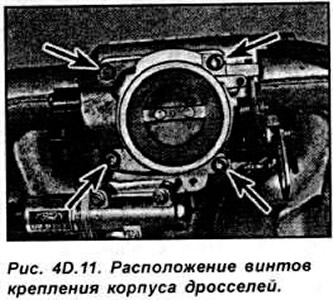
Installation is done in sequence. reverse withdrawal. Before installing, clean the mating surfaces of the throttle body and intake manifold.
Fuel line and fuel injectors
The sequence of operations related to Zetec and Zetec-E engines is given.
Depressurize the fuel system and equalize the pressure in the tank to atmospheric pressure by removing the fuel filler cap. Remove the negative terminal from the battery.
Remove the elements of the air supply system to the engine. Disconnect the accelerator cable from the throttle.
Disconnect the throttle position sensor electrical connector.
Unscrew the screws securing the throttle body, remove it together with the gasket from the intake manifold.
Remove the crankcase breather hose from the cylinder head cover and the pressure regulator vacuum hose from the exhaust manifold. Release the electrical wiring brackets, disconnect the 4 connectors from the fuel injectors and the intake air temperature sensor connector. Disconnect the supply and return fuel pipes. Unscrew the 3 bolts securing the fuel line, remove it with a lever from the intake manifold (see fig. 4D.12).
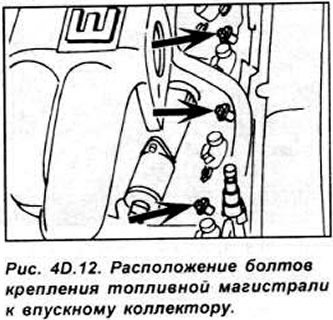
Secure the fuel line in a soft jaw vise, unscrew the 2 bolts securing each fuel injector and remove them.
When replacing fuel injectors, be sure to replace the O-rings. Install in the reverse order of removal.
- lubricate the O-rings with engine oil before installation;
- Install the fuel injectors into the groove in the fuel line, aligning the protrusion on the fuel injector head with the groove in the fuel line. Tighten the nozzle mounting bolts to the required torque;
- install new o-rings on the nose of the fuel injectors and take precautions so that the o-ring does not move when installing the fuel line;
- check that the hoses and electrical connectors are properly connected;
- adjust the accelerator cable;
- Finally, turn on the ignition about 5 times so that the fuel pump pressurizes the fuel system. Check fuel system for leaks.
Fuel pressure control
Depressurize the fuel system and equalize the pressure in the tank to atmospheric pressure by removing the fuel filler cap. Remove the negative terminal from the battery. Disconnect the vacuum hose from the regulator.
Unscrew the 2 screws securing the regulator and remove it (see fig. 4D.13).
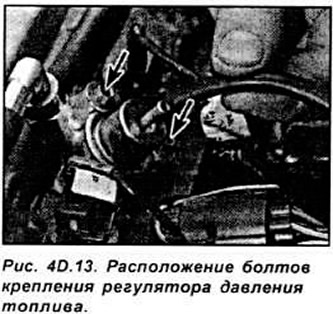
Installation is done in sequence. reverse withdrawal:
- before installing the regulator in place, replace the O-ring and lubricate it with engine oil;
- being careful, install the regulator in the fuel line and secure with bolts;
- turn the ignition on about 5 times to allow the fuel pump to pressurize the fuel system. Check the tightness of the fuel system;
Idle speed control valve
Remove the negative terminal from the battery. Disconnect the electrical connector from the valve.
Unscrew 3 bolts and remove the valve from the intake manifold (see fig. 4D.14).
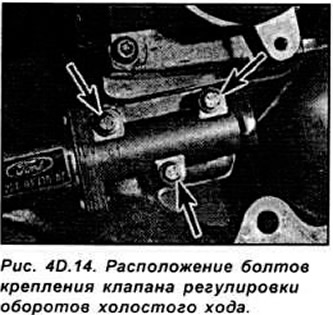
Installation is made in sequence, return to removal.
- clean the mating surfaces and install a new gasket;
- start the engine and warm it up to operating temperature Check the idle speed and stability, then turn on all electrical consumers and check that the idle speed does not change.
Air flow sensor
Disconnect the bracket and remove the electrical connector from the sensor (see fig. 4D.15).
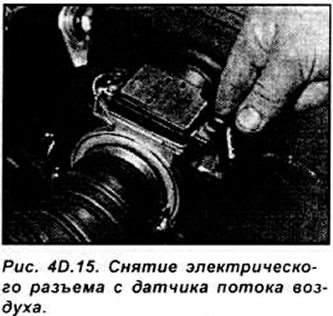
Release the 2 brackets and separate the sensor from the air filter cover (see fig. 4D.16).
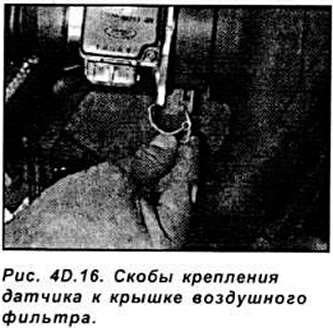
Loosen the clamp and disconnect the sensor from the air supply hose. Remove the sensor.
Installation is done in sequence. reverse withdrawal.
ECU
When working inside the vehicle, remove the upholstery from the front lower part on the passenger side to access the ECU.
Release the ECU from the holder. Unscrew the fixing screws and remove the electrical connector.
Installation is made in sequence, return to removal.
Camshaft position sensor
Release the supply and return fuel hoses from the mounting brackets. Release the electrical wires from the mounting bracket and remove the connector from the camshaft position sensor. Unscrew the mounting screw and remove the sensor from the cylinder head (see fig. 4D.17).
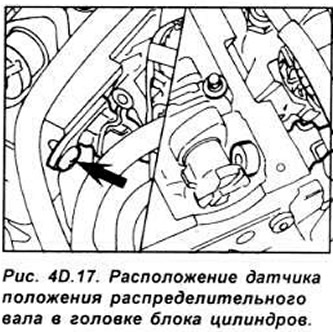
Installation is made in sequence, return to removal.
- before installing the sensor, lubricate the O-ring with engine oil;
- install the sensor in the cylinder head and wipe off the remaining grease;
- tighten the sensor mounting screw to the required torque.
Intake air temperature sensor
The sensor is located in the air cleaner housing on Endura-E engines, in the intake manifold on PTE and Zetec engines, and in the engine air supply hose on Zetec-E engines.
Remove the air cleaner housing or engine air supply piping. Disconnect the electrical connector from the sensor, unscrew it and remove it together with the seal.
Installation is made in sequence, return to removal.
Throttle position sensor
Remove the air cleaner housing or engine air supply piping. Remove the electrical connector from the sensor, unscrew the mounting screws and remove the sensor from the throttle body. Do not rotate the central part of the sensor in the removed position as it is very easy to damage it (see fig. 4D.18).
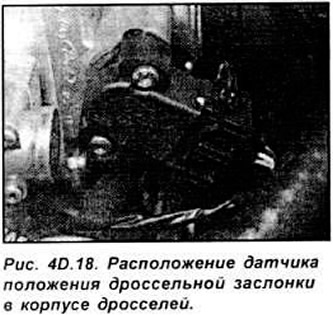
Installation is made in sequence, return to removal. At the same time, precisely align the cut on the throttle shaft with the protrusion on the sensor. Tighten the sensor fastening screws evenly.
Vehicle speed sensor
The speed sensor is mounted on the speedometer drive shaft and is removed together with the drive gear.
Power steering pressure sensor
Remove the electrical connector from the sensor Unscrew it. Place a clean rag under the transducer to catch any escaping fluid. Check the condition of the sensor O-ring and replace it if necessary.
Installation is made in sequence, return to removal. Top up the fluid level if necessary.
Oxygen sensor
Remove the electrical connector from the sensor wire.
Raise the front of the car and secure it on stands. Unscrew the sensor from the exhaust pipe and remove it from below the car (see fig. 40.19).
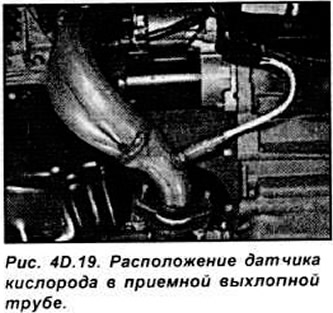
Installation is made in sequence, return to removal. Lubricate the threaded part of the sensor with a non-stick compound.
Visitor comments